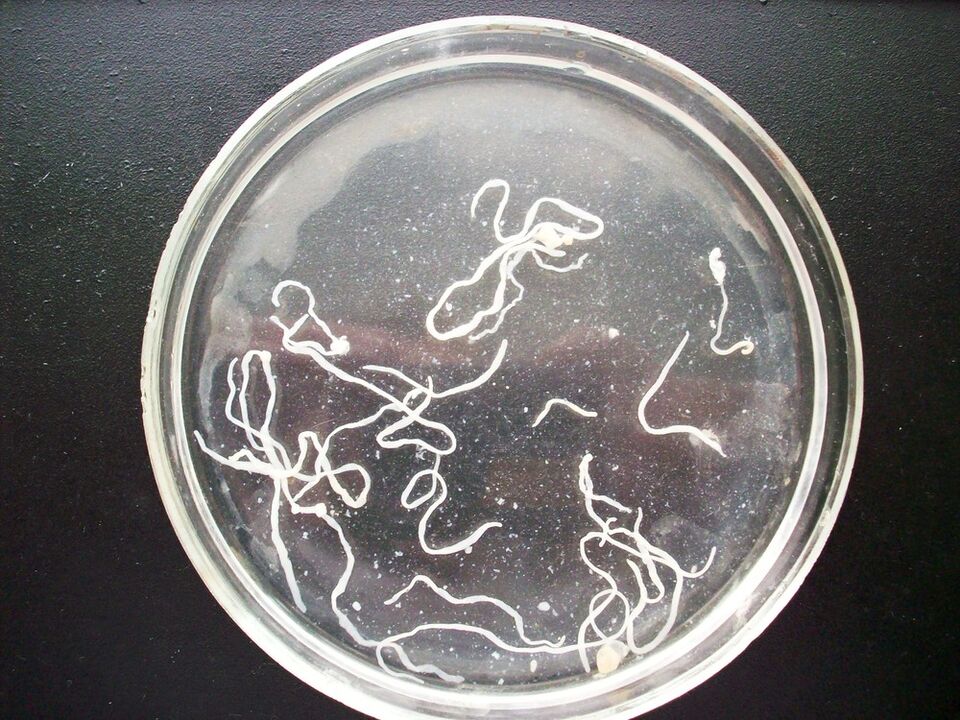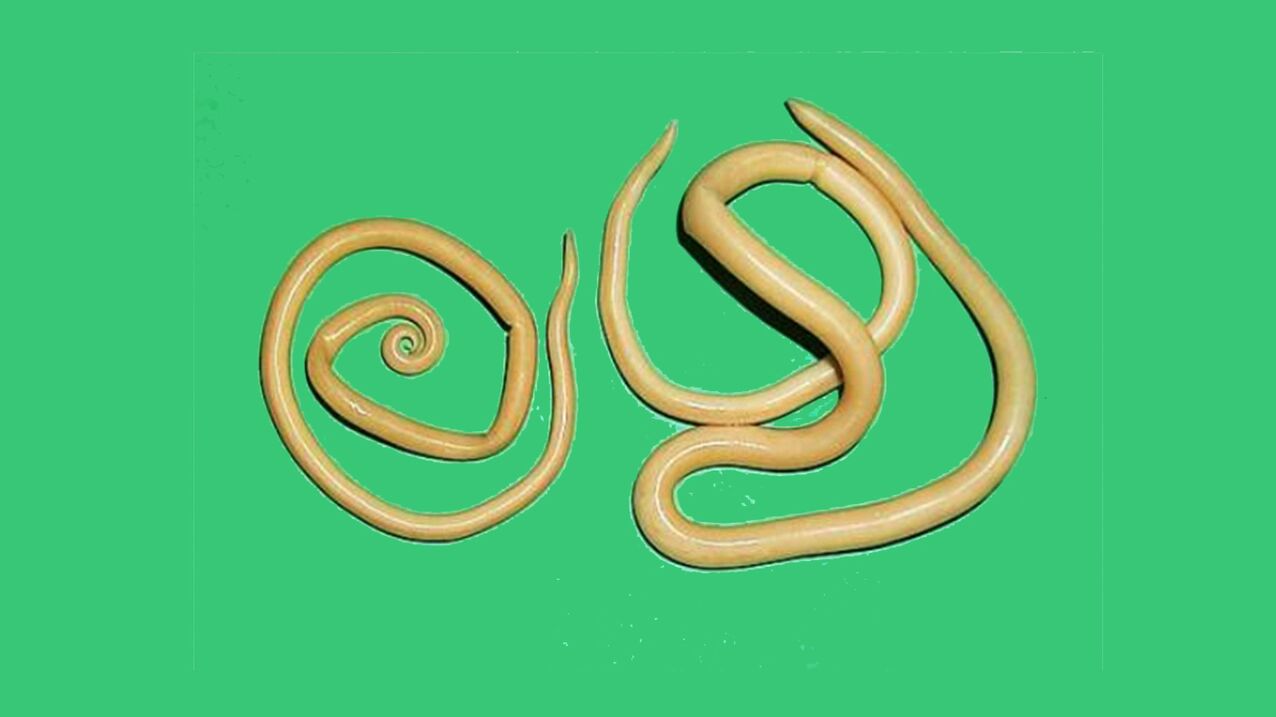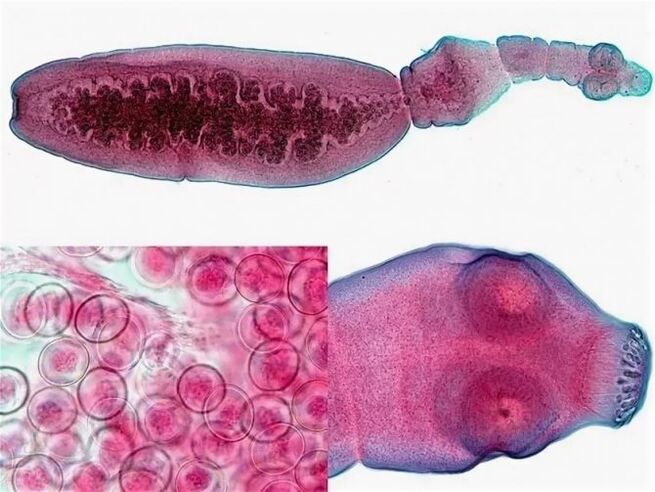
Pinwormis a frequent visitor to children’s groups. This is a medium-sized (up to 1 cm long) resident of the small and large intestines, laying eggs on skin folds, underwear and bedding, leaving the rectum. This happens at night and is accompanied by severe itching in the anus. Worm eggs mature in 4 to 6 hours, can cause disease, and can be perfectly preserved in the environment. They enter the human body through soft toys, underwear and tableware, with dusty and dirty hands.
To make a diagnosis-it needs to be scraped from the skin around the anus and checked under a microscope, at least 3 times every 3 days.
When pin worm eggs are found, the entire infected family should be examined.
In the world, about 350 million people are infected with intestinal helminthiasis. When a family member is infected, all families are at high risk of contracting the disease.
Toxoplasma-parasite
Toxocarais a parasite in the digestive system of dogs. In the United States and Europe, 80% of puppies and more than 50% of adult dogs suffer from toxoplasmosis. Human surveys show that up to 37% of the population is sensitive to Toxocara antigen. This means that these people were or are carriers of Toxoplasma gondii.
Toxocara is 30 cm long and lives in this form in the body of its permanent owner (dog). The dog releases the poisonous eggs into the sand, the soil, where it can last for several years. With sand, they fall into the hands of the children in the sandbox and also stick to shoes and clothes. Entering the human body is a dead end for parasites, because the larvae mature and spread through blood vessels and internal organs, but do not protrude.
In order to make a diagnosis, stool analysis provides no information at all, and a biopsy of the affected organ (usually the liver) and an immunological examination are required.
scarworm-parasite

scar insect disease-affects up to 100 million people every year. It enters the human body along with food (usually uncooked herbs, vegetables and fruits), raw water, dirty hands, and dust, and is actively carried by flies. The worm can be up to 40 cm in length, and a female roundworm secretes up to 200, 000 eggs per day. These eggs enter the soil and remain in the soil for many years. The swallowed roundworm eggs become larvae in the small intestine, then penetrate into the intestinal wall, enter the capillaries, and are transported to the liver, brain, eyes, heart and lungs. During exercise, the roundworm feeds on blood, red blood cells and nutrients. Anemia (anemia) is a common concomitant of ass worm disease.
The migration of larvae can increase the risk of human allergies, general pain, fever, asthma, arthritis, neurodermatitis, eczema, and seizures. If it enters the lungs due to a ruptured blood vessel, it may see exudate under X-rays, which, like tuberculosis, can cause bleeding and hemoptysis.
Along the bronchi to the pharynx, the roundworm with round enters the mouth, and then enters the esophagus, stomach and intestines from there. In the intestines, roundworms are retained, leaning against the intestinal wall, causing inflammation, infiltration and bleeding. When roundworms enter the sinuses, liver, bile ducts, pancreas, and kidneys, they may cause complications. The abdominal cavity has intestinal obstruction and purulent process. Diagnosis is based on fecal analysis (at least 3 times) in the larval stage and immunological examination.
Hookworm-Parasite
Hookworm-When walking barefoot, it can enter people through the skin (it leaves no traces), or it can enter the human body through the mouth like a round worm. Hookworm size-up to 1. 5 cm, migrating and harming in the same way as roundworms. It is characterized by itchy rashes and more obvious symptoms such as anemia.
For most intrusions, stool analysis needs to be performed at least 3 times.
Wide Ribbon-Parasites

Broadstriped wormis a large long liver,a person can be up to 10 meters in length and live up to 25 years in the human body.If there are a few such centenarians inside, can you imagine what would happen to one person?
Imagine the way the worm twists in the intestine. There is very little space left in the human intestinal cavity! If the worm "straighten", half of its length will stick out! By the way, worms absorb all necessary and useful substances on the entire body surface.
You can get infected by eating raw, insufficiently salty fish, crayfish and caviar. Symptoms of a worm may be anemia, exhaustion, abdominal pain, especially in the morning with increased saliva, vomiting, nausea, weakness, lethargy, lethargy and other signs. Intestinal obstruction is possible.
The severed "tail" that releases the parasite from the intestine can have a completely shocking effect on unprepared people-this is a characteristic of worms and helps in making a diagnosis.
Cow and pork tapeworms are parasites
Cow and pork tapeworms are parasites that enter the human body along with raw meat, meat products, and lard.
The length of adult cattle tapeworm is up to 7 meters, and the length of pork tapeworm is up to 2 meters, and the longest life span is 20 years. The main danger is the migration of larvae, which can even penetrate into the eyes andbrain.
Echinococcus oc and pneumococcus-parasites

Echinococcus and pneumococcus are parasites infected by human and animal carriers, drinking contaminated water, and swallowing soil with berries and vegetables.
The larvae from the intestine are carried by the bloodstream throughout the body and enter the liver, lungs, kidneys, bones and brain. The larva transforms into a cyst that grows by pushing and squeezing the surrounding tissue. Symptoms depend on the location of the cyst and the degree of compression on the organ.
A ruptured cyst is a terrible complication.
Giardia-Parasite
Giardiais the simplest parasitic animal in flagella. It is pear-shaped and has a length of 10–20 µm. The dorsal side is convex and the ventral side is concave, and forms a suction cup for temporary attachment to the epithelial cells of the host intestine. There are 2 oval nuclei and 4 pairs of flagella. It lives in the human intestine (mainly in children), mainly in the duodenum, and rarely in the bile ducts and gallbladder, causing Giardiasis. Asymptomatic parasitic vectors are common. When contaminated food or water enters the human body, protozoa enter the lower intestine through the mouth, and enter the cyst through dirty hands. The onset is sporadic. Giardiasis is common all over the world.



































